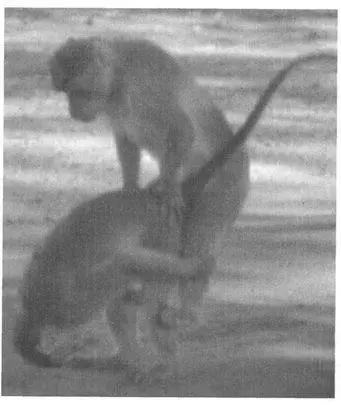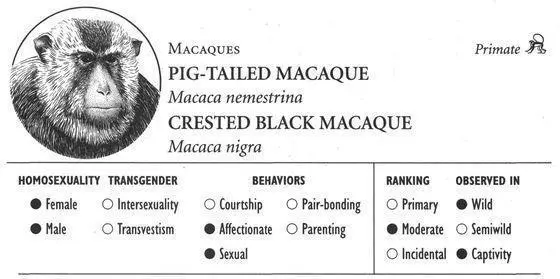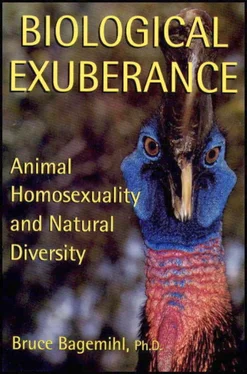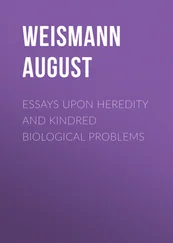An older male Bonnet Macaque in India mounting a younger male

Frequency: Homosexual mounting is very common in male Bonnet Macaques. In some populations, same-sex mounts exceed the number of heterosexual mounts by as much as four to one, and mounting between males can comprise 31 percent to 79 percent of all mounting. Sexual and affectionate behaviors between males occur in about a quarter of their interactions with one another. Female homosexual activity is somewhat less common: one study found that mounting between females occurred at rates that were two to seven times less than male-female or male-male mounting, although the rates of mutual rump rubbing with genital stimulation between females were only slightly less than between males. In Crab-eating Macaques, homosexual mounting accounts for 17–30 percent of mountings, and 10 percent of all interactions between males involve mounting (compared to nearly 50 percent of all interactions between males and females).
Orientation: Nearly all male Bonnet Macaques participate in both homosexual and heterosexual mounting, but it appears that they generally have more different male partners than female ones. Some males participate very little in homosexual activity (accounting for about 10 percent of the same-sex mountings in a population), while others may be involved in more than half of all homosexual mounts. A similar variation occurs with respect to their heterosexual participation. However, males that are the least active heterosexually are not necessarily the most active homosexually: in many cases, those males that participate in a large number of homosexual mountings also have a large number of heterosexual mountings. No quantitative information on sexual orientation is available for Crab-eaters; however, observations in captivity indicate that males engage in both homosexual and heterosexual copulation, sometimes alternating relatively frequently between the two. Furthermore, males that are “bonded” to one another show a preference for their partner that even survives separation and intervening heterosexual activity. If such males are separated from one another, they rush to embrace each other on being reunited, resuming their sexual relationship where they left off.
Nonreproductive and Alternative Heterosexualities
As noted above, heterosexual matings in Crab-eating Macaques are not always consensual: about 19 percent of such mounts are forced by the male on the female. Furthermore, male Crab-eaters sometimes severely attack females with small babies and also occasionally kill those infants to gain sexual and breeding access to the female. Both Bonnets and Crab-eaters participate in a range of nonprocreative sexual behaviors. Among Crab-eaters, females copulate during pregnancy (though usually not during the first two to three weeks), while more than half of male-female copulations do not involve ejaculation. In both species, females have multiple male partners and copulations—during one six-month period, for example, each female Crab-eater mated an average of 45 times, with some copulating more than 110 times. Female Bonnets may mate with up to three different males in succession, and females also sometimes mount males (REVERSE mounting). Male Bonnet Macaques may also manually penetrate females, inserting a finger and then licking or smelling it. Unlike in a number of other primates, in Bonnets this behavior does not appear to be simply a way of testing the sexual receptivity of the female. Both male and female Bonnets also masturbate, females sometimes employing innovative techniques (such as using objects or pulling their tail between their legs and using it to rub their labia while making pelvic thrusting movements). Crab-eating Macaques engage in an interesting form of “infidelity”: heterosexual mating typically occurs within a short-term bond or consortship. However, nearly 20 percent of all copulations in some populations are nonmonogamous: half of all females and almost three-quarters of the males “steal” matings with other partners during a consortship, but return to their original partner afterward. The social system of Bonnet Macaques may entail considerable inbreeding, and incestuous mother-son matings that produce viable offspring do occur.
Sources
*asterisked references discuss homosexuality/transgender
*Bernstein, S. (1970) “Primate Status Hierarchies.” In L. A. Rosenblum, ed., Primate Behavior : Developments in Field and Laboratory Research , vol. 1, pp. 71–109. New York: Academic Press.
Emory, G. R., and S. J. Harris (1978) “On the Directional Orientation of Female Presents in Macaca fascicularis.” Primates 19:227–29.
*Hamilton, G. V. (1914) “A Study of Sexual Tendencies in Monkeys and Baboons.” Journal of Animal Behavior 4:295–318.
*Kaufman, I. C., and L. A. Rosenblum (1966) “A Behavioral Taxonomy for Macaca nemestrina and Macaca radiata : Based on Longitudinal Observation of Family Groups in the Laboratory.” Primates 7:205–58.
*Makwana, S. C. (1980) “Observations on Population and Behavior of the Bonnet Monkey, Macaca radiata.” Comparative Physiology and Ecology 5:9–12.
Moore, J., and R. Ali (1984) “Are Dispersal and Inbreeding Avoidance Related?” Animal Behavior 32:94–112.
*Nolte, A. (1955) “Field Observations on the Daily Routine and Social Behavior of Common Indian Monkeys, with Special Reference to the Bonnet Monkey ( Macaca radiata Geoffroy ).” Journal of the Bombay Natural History Society 53:177–84.
Noordwijk, M. A. van (1985) “Sexual Behavior of Sumatran Long-tailed Macaques ( Macaca fascicularis).” Zeitschrift für Tierpsychologie 70:277–96.
*Poirier, F. E., and E. O. Smith (1974) “The Crab-Eating Macaques ( Macaca fascicularis ) of Angaur Island, Palau, Micronesia.” Folia Primatologica 22:258–306.
Rahaman, H., and M. D. Parthasarathy (1969) “Studies on the Social Behavior of Bonnet Monkeys.” Primates 10:149–62.
*———(1968) “The Expressive Movements of the Bonnet Macaque.” Primates 9:259–72.
*Rasmussen, D. R. (1984) “Functional Alterations in the Social Organization of Bonnet Macaques ( Macaca radiata ) Induced by Ovariectomy: An Experimental Analysis.” Psychoneuroendocrinology 9:343–74.
*Silk, J. B. (1994) “Social Relationships of Male Bonnet Macaques: Male Bonding in a Matrilineal Society.” Behavior 130:271–92.
———(1993) “Does Participation in Coalitions Influence Dominance Relationships Among Male Bonnet Macaques?” Behavior 126:171–89.
Sinha, A. (1997) “Complex Tool Manufacture by a Wild Bonnet Macaque, Macaca radiata .” Folia Primatologica 68:23–25.
*Simonds, P. E. (1996) Personal communication.
*———(1965) “The Bonnet Macaque in South India.” In I. DeVore, ed., Primate Behavior: Field Studies of Monkeys and Apes , pp. 175–96. New York: Holt, Rinehart, & Winston.
*Sugiyama, Y. (1971) “Characteristics of the Social Life of Bonnet Macaques ( Macaca radiata ).” Primates 12:247–66.
*Thompson, N. S. (1969) “The Motivations Underlying Social Structure in Macaca irus.” Animal Behavior 17:459–67.
*———(1967) “Some Variables Affecting the Behavior of Irus Macaques in Dyadic Encounters.” Animal Behavior 15:307–11.

PIG-TAILED MACAQUE
IDENTIFICATION: A medium-sized monkey (up to 30 pounds in males) with olive-brown fur and a short, curly, nearly naked tail. DISTRIBUTION: Southeast Asia from Burma to Sumatra; vulnerable. HABITAT: Forests. STUDY AREAS: Near Mt. Kerinci, West Sumatra, Indonesia, subspecies M.n. nemestrina; Bernam River, western Malaysia; Washington and Yerkes Regional Primate Research Centers; State University of New York; Turin Zoo.
Читать дальше














